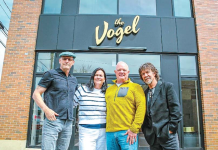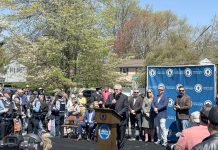
By Sunayana Prabhu
SHREWSBURY – Not convinced by the professional planner’s testimony, residents continued to argue against Martelli Development Group’s bifurcated application for a land use variance to replace an existing house with an office building in historic downtown Shrewsbury.
At the special land use board meeting June 29, Veena Sawant, professional planner, on behalf of Martelli Development Group, presented her testimony on the site’s suitability, arguing that renovating the existing house into a “limited-use office building” is the most “benign” adaptive re-use of a house that is currently in disrepair.
The 3.44-acre parcel is heavily wooded, sits next to Manson Field and abuts the Shrewsbury Municipal Complex and the Thornbrooke community. It is in close proximity to the historic four-way intersection at Broad Street and Sycamore Avenue which is dotted with landmarks like Christ Episcopal Church, the Quaker Meeting House and the historic Allen House. The speed limit on this stretch of Route 35 was recently reduced to 35 mph from 40.
Martelli plans to renovate the existing residential dwelling into a commercial office, hence the two-part application for a use variance. The property, located at 942 Broad St., is locally referred to as the Judd property. Martelli has a purchase contract with the current property owner Michael Lynn.
According to borough code, the property is currently in the PSC-1 zone or Planned Senior Citizen Development zone that also opens it to single-family residential projects, Sawant said in her testimony. Besides approximately “3-4 single family homes,” the zone allows for farms and other uses for agricultural purposes, borough parks, playgrounds, municipal buildings and public buildings of a cultural nature. She further added that using the property as a proposed office building would be the “best” use. If the owner instead decided to subdivide the property into single-family homes it would pose “significant constraints” on the community and “would result in practical difficulties or unnecessary hardships.”
However, many residents did not agree with Sawant’s testimony which one deemed based on the “lesser of all evils” argument. Resident Richard Sabel, echoing several residents at the meeting said, “We don’t like that.”
Borough administrator and land use board member Christopher Cherbini said Sawant was “forecasting” with the prospect of single-family homes which are “not feasible at this point anyway.”
But Sawant disagreed. “I’m not trying to forecast,” she said, noting the reason she brought up single-family homes is because “that is what is permitted by the zoning.” Also, she added that if the property owner rightfully goes before the board for a subdivision then “that would have more impact,” compared to a limited-use office.
Drawing applause from the attending residents, Cherbini asked, “How about the (existing) single-family home? Why can’t it just be a single-family home?”
“It is only fair to be able to develop (the property) to the full potential, otherwise it is underutilized,” replied Sawant.
She also noted the project is consistent with the overall objectives of the borough’s 2014 Master Plan and municipal land use law. In the borough’s master plan reexamination report the one-acre of the property that includes wetlands should have been “caught” and designated as a state-owned ROSI (Recreation Open Space Inventory) or put to environmental, recreational uses, Sawant said.
“I don’t know why it was not considered, but I did go through the master plan thoroughly,” she said, and “the most interesting thing I found was that the property was slated for open space.”
Martelli’s attorney, Bernard Riley, tried to convince the board members and residents that the benefits of this proposal outweigh any substantial detriments.
At the Thursday meeting, Riley said Martelli has offered to donate one acre to the borough through a deed restriction and maintain it as open space. Additional conditions the developer has agreed to are: no heavy trucks over 15,000 pounds; no construction vehicles on the site, except during the actual renovations and construction; a maximum of nine employees will work on-site daily; the total number of vehicles allowed is 14, with 11 vehicles in the parking lot and three additional in the garage; second-floor garage space will be limited to storage use only; the property would be used only as a single entity business office, there would be no medical use and there would be no sublease of the premises to other business entities.
Sawant also clarified that the property is not actually within the historic district, conceding that it does abut it. “We respect that there are homes that have a very rich architecture and we are trying to mimic that as much as possible,” she said.
Unconvinced, seniors from the adjacent active adult community at Thornbrook cited several problems related to traffic flow and said they would continue to oppose the plan at the next land use board meeting to be held Aug. 2.
The article originally appeared in the July 6 – 12, 2023 print edition of The Two River Times.














